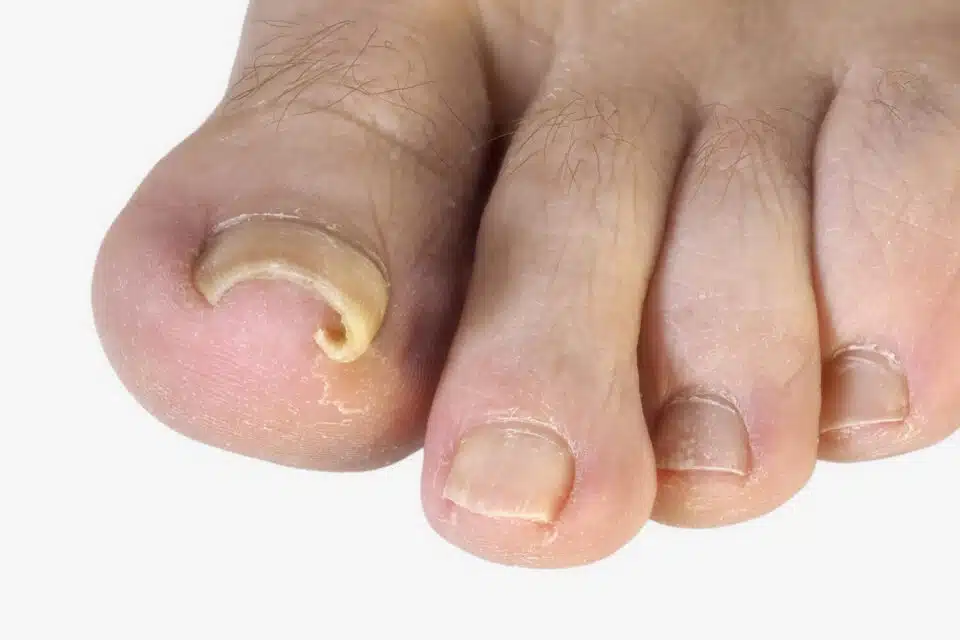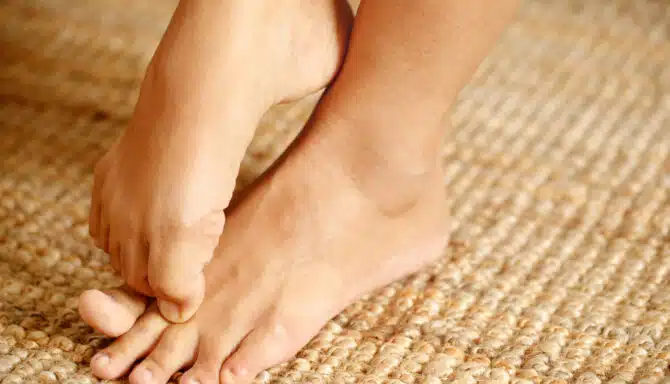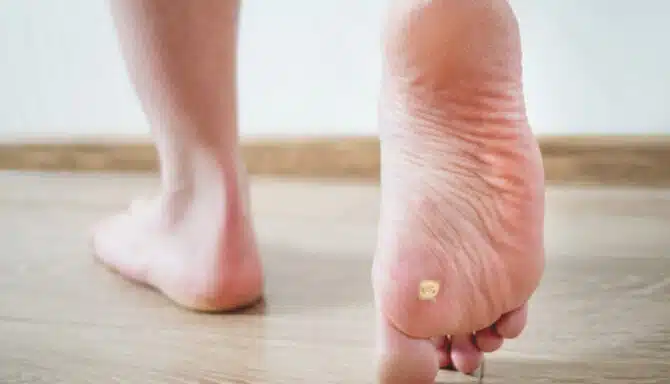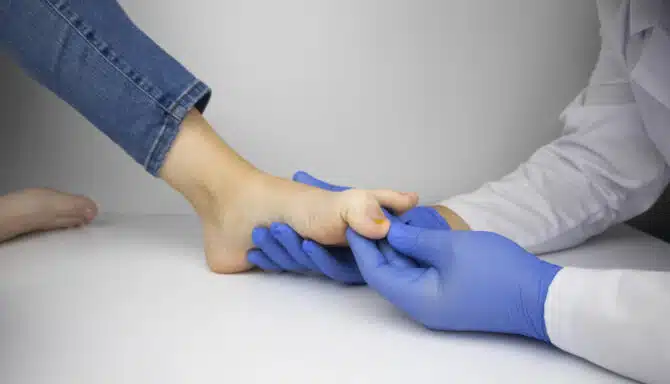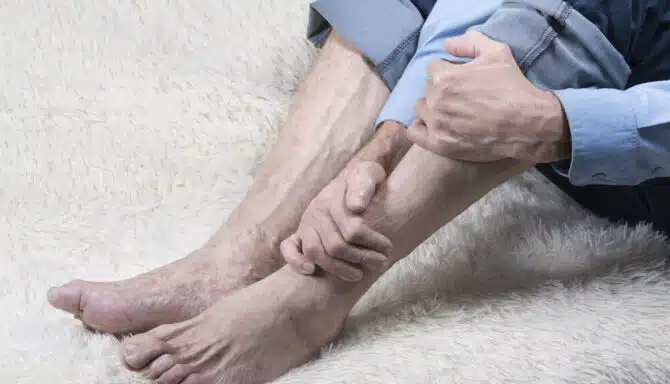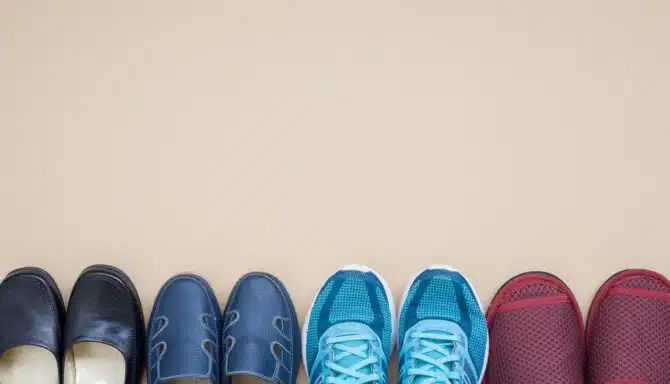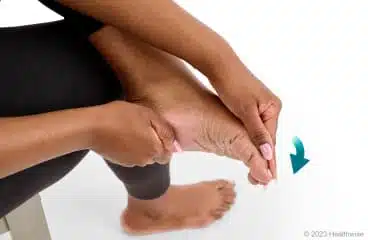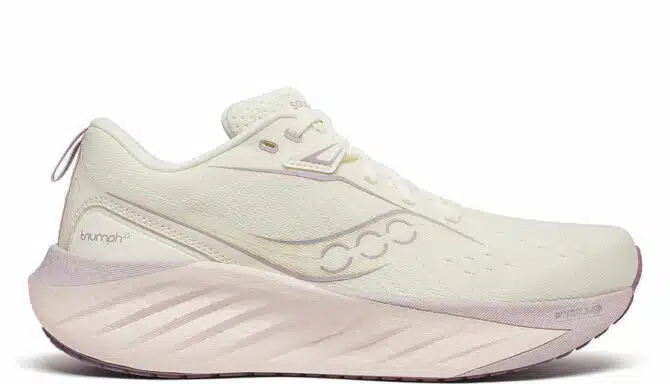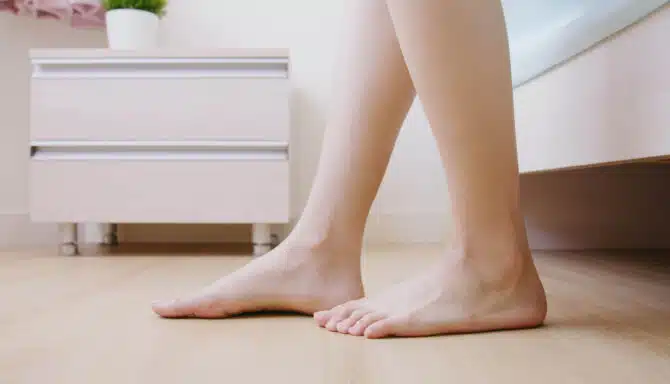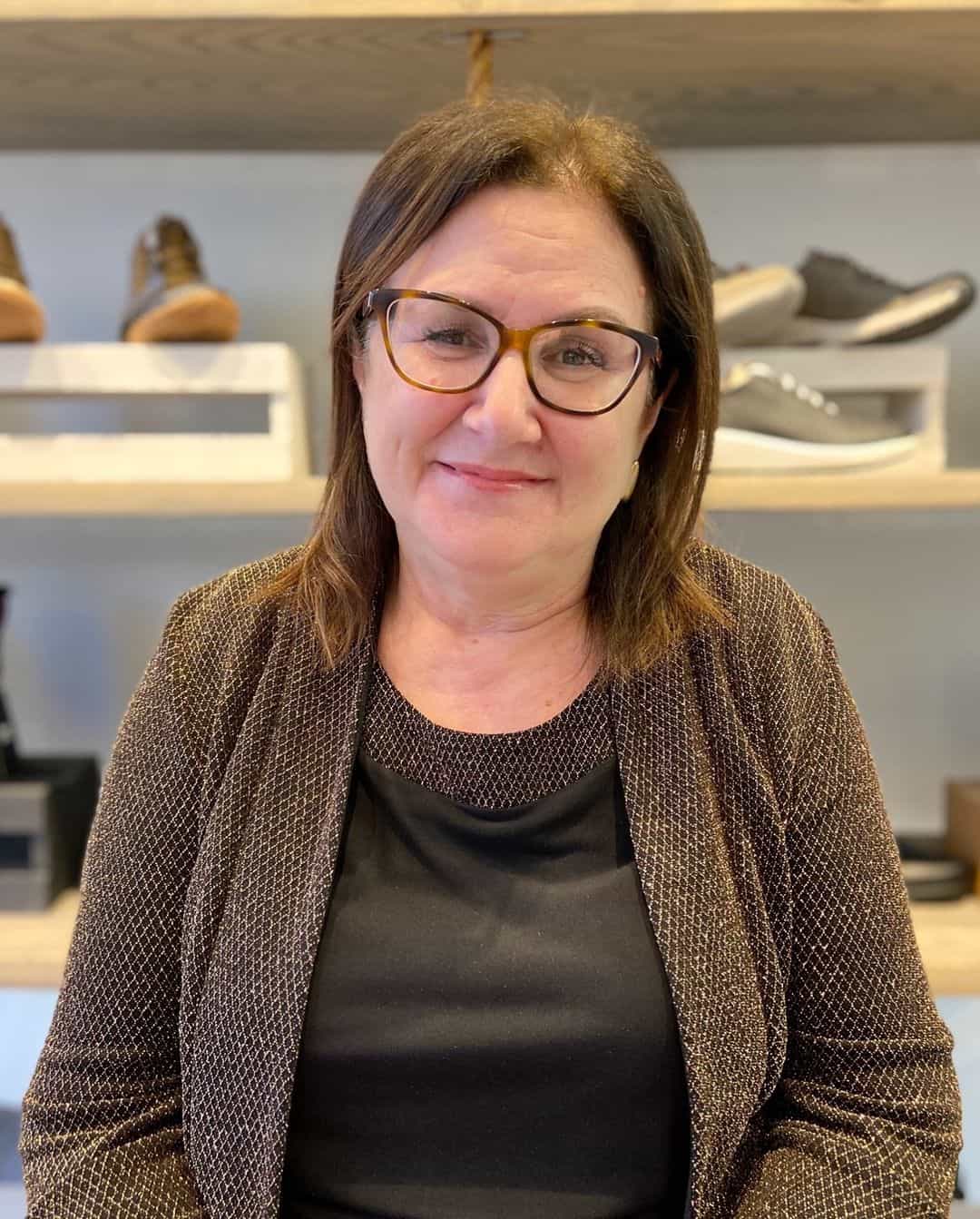Curved toenails can indicate various underlying toenail conditions, each with unique causes and additional characteristics. They also don’t always look the same. Toenail curvature issues can range from having a severe Ram’s Horn toenail, accompanied by other symptoms like thickening and discoloration, or small pincer nails that pierce your skin. Let’s learn about curved toenail causes, and most importantly, how a chiropodist or podiatrist can treat curved toenails at a foot clinic so complications don’t arise.
Why Do Toenails Curve?
To understand the best ways of preventing curved toenails, it’s important to learn how healthy toenails grow. They should naturally grow forward in a slightly arched but mostly flat shape, following the contour of the toe. This process begins in the nail matrix, the tissue under the skin at the base of the nail, where specialized cells produce layers of keratin—the protein that makes up the nail.
As new cells form, older cells are pushed outward, harden, and form the visible nail plate. Ideally, the nail grows evenly and straight across, guided by both the shape of the matrix and the direction of mechanical forces applied to the toe, like walking or wearing shoes. The nail bed beneath provides support and helps keep the nail anchored and flat as it grows. A balance between nail thickness, width, and surrounding skin tension is key to maintaining this typical shape.
Toenails start to curve when something disrupts this balance.
Repetitive Trauma from Ill-Fitting Footwear
One common reason is uneven pressure and toe crowding. Tight footwear or repetitive trauma can push the nail’s edges downward or inward over time. That’s why one of the best ways of preventing curved toenails, or virtually all foot conditions for that matter, is purchasing and wearing only shoes that fit properly, allow your toes to splay comfortably, and have ample cushioning, arch support and shock absorption. It’s better to have a small selection of solid, high-quality shoes that support foot health than several pairs of low-quality, poorly designed shoes that cramp your toes.
Genetics
Genetics also play a role in abnormal toenail growth; some people naturally have a more curved nail matrix or a narrower nail bed, both of which can encourage curling. If keratin production is uneven—say, one side of the nail grows faster than the other—the nail can begin to twist or curve as it extends.
Underlying Health Conditions
Inflammatory conditions, infections, poor circulation, or chronic diseases like diabetes can also interfere with normal nail growth by altering cell turnover in the matrix or causing changes to the skin and tissue around the nail. As a result, curved toenails are often not just a cosmetic issue—they can signal deeper structural or health-related concerns.
Curved Toenail Causes
Whether your curled toenails are the result of a sinister condition or simply a genetic growth pattern you’ve inherited, preventing them from getting worse is key. No matter the cause, proper trimming (straight across with simple nail clippers) and wearing shoes that fit well are two of the best things you can do from home to prevent painful complications and live life as comfortably as possible. Below you’ll find some of the most common causes of curved toenails:
Ingrown Toenails (Onychocryptosis)
Ingrown toenails are tricky as they look deceptively mild. But complications, like painful infections, can arise if you ignore them. They develop when the edge of a curved toenail grows into the surrounding skin, causing swelling, redness, and sensitivity. They can look curved, but they also look like a small “extra nail” on the edge of the main nail. It most commonly affects the big toe, and naturally curved toenails (involuted nails) are more likely to become ingrown because their growth pattern is already unusual.
Trimming the nails too short or rounding the edges can also encourage the skin to fold over the nail edge, allowing it to grow inward instead of outward. Repeated pressure or trauma from sports, stubbing the toe, or restrictive footwear (in the toe box, like narrow, pointed high heels) can also disrupt normal growth and set the stage for an ingrown nail to form.
Pincer Nails (Trumpet Nails)
Classified by podiatrists and chiropodists as “the most painful type of ingrown toenail,” pincer nails, or trumpet nails, occur when the sides of the toenail curve inward toward each other, sometimes so dramatically that the edges look like they want to meet underneath the toe!
This shape creates a pinching effect on the nail bed and surrounding tissue. While some people are born with a naturally curved nail structure that gradually tightens over time, others develop this condition due to external pressures. Long-term use of tight shoes, particularly those with narrow toe boxes, is a major contributing factor. Certain systemic conditions, such as autoimmune disorders or circulatory problems, may also affect the nail matrix and contribute to this unusual curvature. Additionally, aging can play a role, as nail shape and growth patterns tend to change over time.
Onychogryphosis (Ram’s Horn Nails)
Onychogryphosis is a condition where the toenail becomes dramatically thickened and begins to grow in a distorted, curved, or spiraled shape that resembles a ram’s horn. It often affects the big toe and progresses gradually over time. The nail’s irregular growth is usually the result of uneven cell production in the nail matrix, where one side grows faster than the other.
The most common causes include repetitive trauma (like years of wearing ill-fitted shoes), long-standing fungal infections, or neglect of nail trimming. It’s more frequently seen in older adults or individuals with limited mobility who may struggle with basic foot care. Certain systemic conditions, including psoriasis and vascular disorders, may also interfere with healthy nail growth and lead to this thickened, curved form.
Curved Toenail Pain Relief and Solutions: Nail Disorder Treatment
Toenail curvature can cause pain and nagging discomfort that disrupts your daily life. Remember, the nail should not be growing this way, and it’s up to you to take the first step towards finding a solution. Chiropodists and podiatrists offer several effective treatments to address curved toenails, tailored to the severity and underlying causes. Below are some common treatments available at foot clinics:
Proper Fitting Footwear
Wearing shoes that are the correct length 0with a wide toe box is crucial for preventing and alleviating discomfort associated with curved toenails. Footwear that allows ample space for the toes reduces pressure on the toenails, minimizing the risk of them growing into the surrounding skin. Properly fitting shoes not only aid in preventing the development or worsening of curved toenails, but also provide some pain relief for existing conditions that need accommodation. Ensuring that shoes complement the natural shape of the foot without squeezing or compressing the toes is a simple yet effective measure in maintaining toenail health.
Medical Pedicures
Medical pedicures are performed by trained chiropodists or podiatrists and focus on the health and hygiene of the feet and nails. Unlike cosmetic pedicures, these procedures address underlying issues and focus more on nail maintenance and health than aesthetic appearances (although the nails always look clean and fresh afterwards!). During a medical pedicure, the specialist will carefully trim and reshape the toenails using sterilized instruments, reducing the risk of further complications.
They are a common treatment for people with diabetes who cannot cut and clean their nails properly without assistance, and who need an extra set of eyes and expertise to spot abnormalities.
OnyFix Nail Correction System
The OnyFix system is a non-invasive, highly innovative, and pain-free treatment designed to correct curved toenails—especially ingrown toenails. It involves applying a specialized composite material to the nail, which hardens and acts as a brace, guiding the nail to grow in its natural shape without exerting direct force. This method is suitable for various nail shapes and is particularly beneficial for patients seeking an alternative to surgical interventions. The Onyfix system allows individuals to continue their daily activities without restrictions, including swimming and wearing nail polish.
Nail Avulsion Surgery
In severe cases, such as with ram’s horn toenail, surgical intervention may be recommended. This procedure involves the partial or complete removal of the affected toenail under local anesthesia. By removing the deformed nail, the underlying tissue can heal properly, and a healthier nail may regrow. Alternatively, a solution called phenol may be used to prevent nail regrowth.
